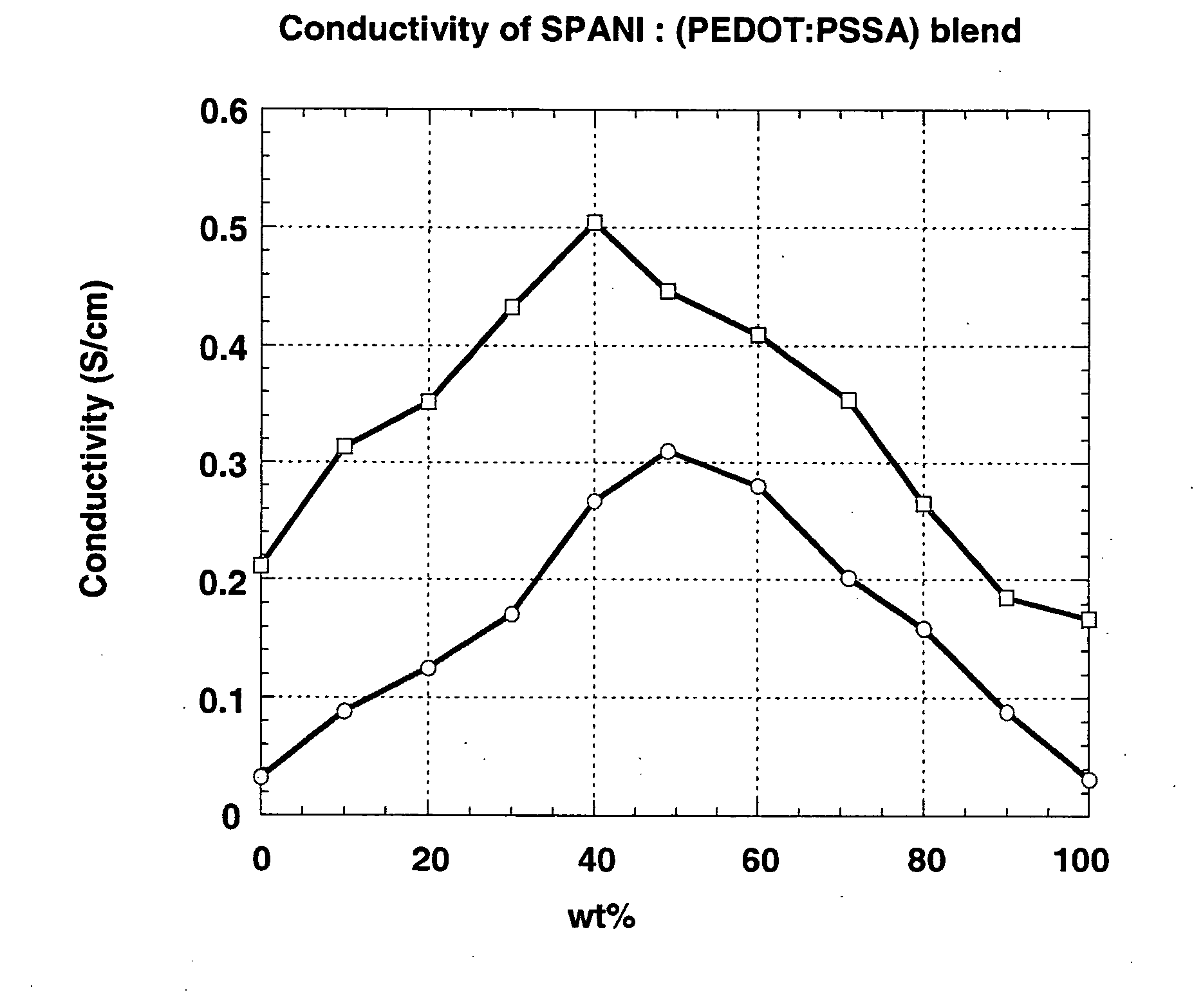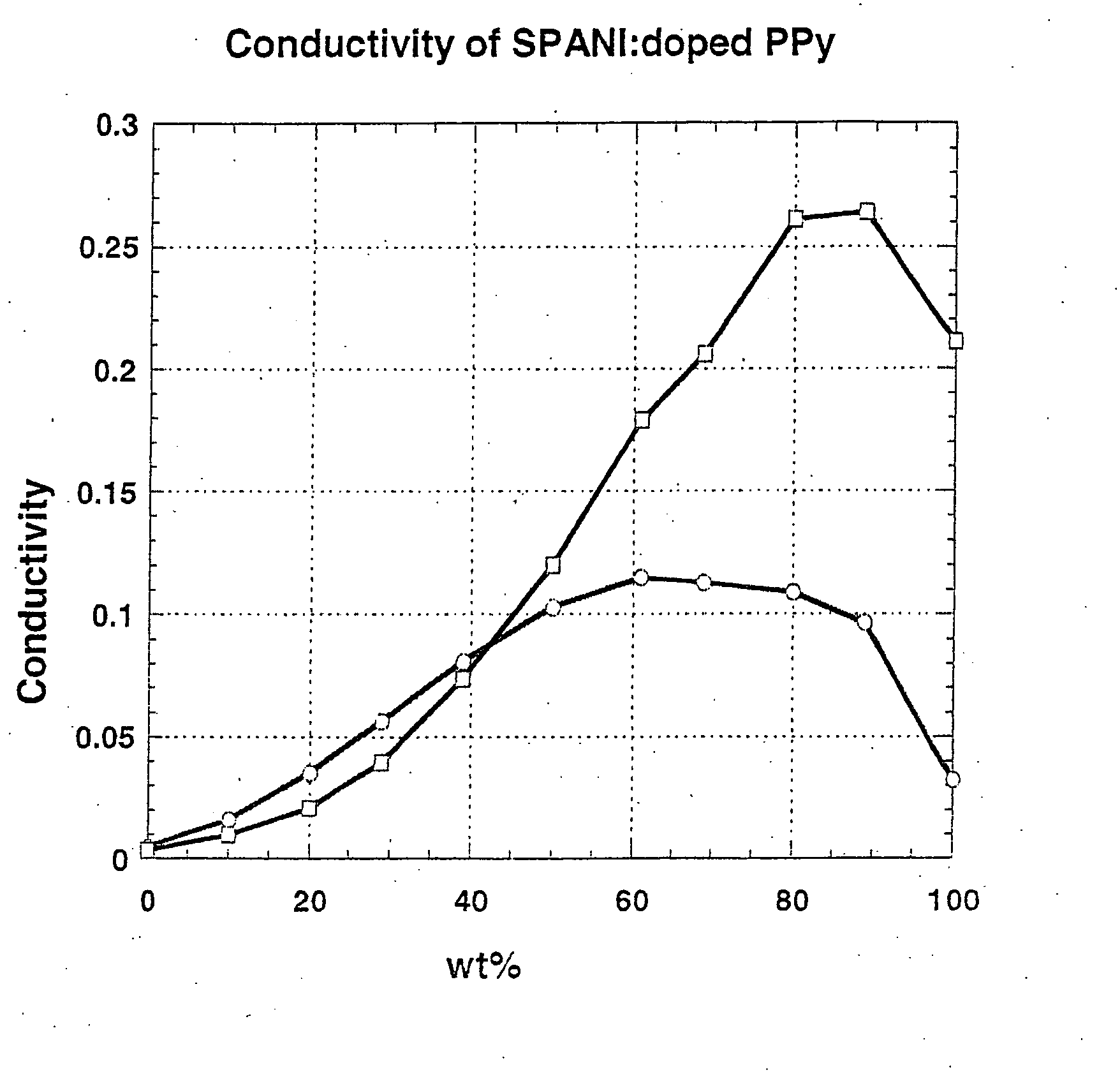Aqueous blends and films comprising a first electrically conducting conjugated polymer and a second electrically conducting conjugated polymer
a technology of conjugated polymer and film, which is applied in the direction of conductive layer on insulating support, non-conductive material with dispersed conductive material, chewing gum, etc., can solve the problems of limited electrical conductivity enhancement of weaker acids, which generally yield limited electrical conductivity enhancement, and are rarely studied. , to achieve the effect of convenient formation
- Summary
- Abstract
- Description
- Claims
- Application Information
AI Technical Summary
Benefits of technology
Problems solved by technology
Method used
Image
Examples
example 1
Blends of SPANI and PEDOT
[0093] Blends of SPANI (5 wt % water dispersion from Aldrich Chemical Co., Inc. Milwaukee, Wis., CAS# 167860-86-8) and BAYTRON P V4071 PEDOT (0.5 wt % PEDOT and 0.8 wt % PSSA in water; from Bayer Corp., Pittsburg, Pa.) (PEDOT:PSSA) were prepared by mixing SPANI dispersion and PEDOT:PSSA dispersion at the weight ratios listed in Table 1. Films were then spin coated onto glass substrates using the blends at a spin rate of 600 rpm. For comparison, films of SPANI and PEDOT:PSSA were also spun coated under the same condition. The conductivities were measured using a Signatone four point probe (Signatone Corp, Gilroy, Calif.) in combination with a Keithley 2400 SourceMeter (Keithley Instruments Inc., Cleveland, Ohio). The four-point probe method is well known in the art and shall be given its ordinary definition as set forth in the art. The films were then annealed at 200° C. for 2 min under nitrogen protection, and the conductivities were measured again. Thickne...
example 2
Blends of SPANI and Doped Poly(Pyrrole) (PPy)
[0095] Blends of SPANI (5 wt % water dispersion from Aldrich, CAS# 167860-86-8) and PPy doped with organic acids (OA) (5 wt % dispersion in water from Aldrich, CAS# 30604-81-0) (PPy:OA) were prepared by mixing SPANI dispersion and PPy:OA dispersion at the weight ratios listed in Table 2. Films were then spin coated onto glass substrates using the blends at a spin rate of 600 rpm. For comparison, films of SPANI and PPy:OA alone were also spun coated under the same condition. The conductivities were measured using a Signatone four point probe in combination with a Keithley 2400 SourceMeter. The films were then annealed at 200° C. for 2 min under nitrogen protection, and the conductivities were measured again. Thickness of the films was measured using a KLA Tencor P-15 profilometer. The results are presented in Table 2 and in FIG. 2. The enhancement in conductivity of both as spun and annealed films is demonstrated.
TABLE 2Conductivities o...
example 3
Blends of PEDOT:PSSA and PPy:OA
[0096] Blends of Baytron P V4071 PEDOT (0.5 wt % PEDOT and 0.8 wt % PSSA in water; from Bayer Corp.) (PEDOT:PSSA) and PPy doped with organic acids (PPy:OA) (5 wt % dispersion in water from Aldrich, CAS# 30604-81-0) were prepared by mixing PEDOT:PSSA dispersion and PPy:OA dispersion at the weight ratios listed in Table 3. Films were then spin coated onto glass substrates using the blends at a spin rate of 600 rpm. For comparison, films of PEDOT:PSSA and PPy:OA were also spun coated under the same condition. The conductivities were measured using a Signatone four point probe in combination with a Keithley 2400 SourceMeter. The films were then annealed at 200° C. for 2 min under nitrogen protection, and the conductivities were measured again. Thickness of the films was measured using a KLA Tencor P-15 profilometer. Table 3 summarizes the results. FIG. 3 graphically represents the results.
TABLE 3Conductivities of PEDOT and PPy, and their blend filmsPpy:...
PUM
| Property | Measurement | Unit |
|---|---|---|
| conductivity | aaaaa | aaaaa |
| wt % | aaaaa | aaaaa |
| electrical conductivities | aaaaa | aaaaa |
Abstract
Description
Claims
Application Information
 Login to View More
Login to View More - R&D
- Intellectual Property
- Life Sciences
- Materials
- Tech Scout
- Unparalleled Data Quality
- Higher Quality Content
- 60% Fewer Hallucinations
Browse by: Latest US Patents, China's latest patents, Technical Efficacy Thesaurus, Application Domain, Technology Topic, Popular Technical Reports.
© 2025 PatSnap. All rights reserved.Legal|Privacy policy|Modern Slavery Act Transparency Statement|Sitemap|About US| Contact US: help@patsnap.com



